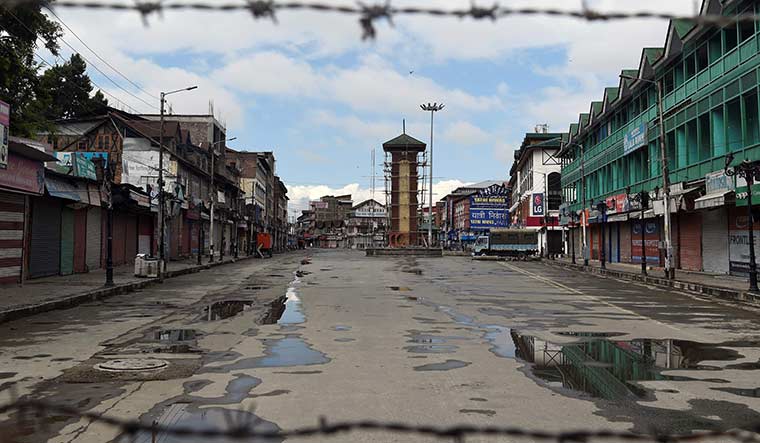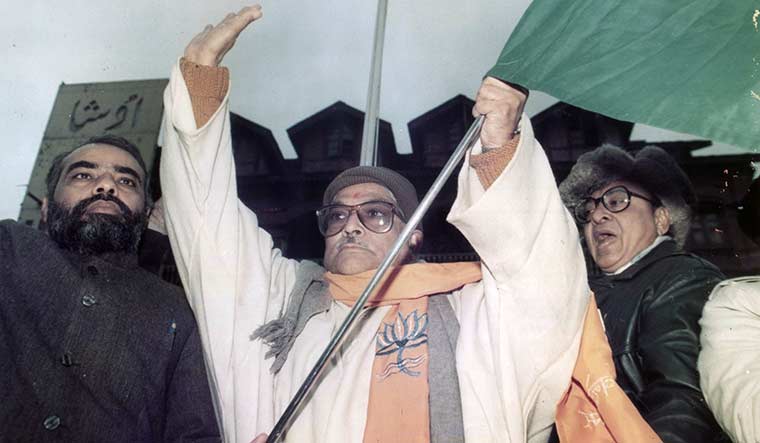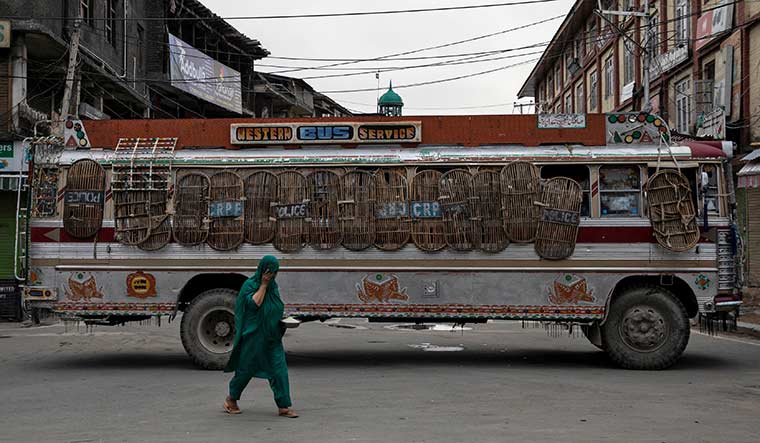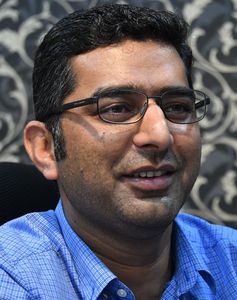ARTICLE 370 OF the Indian Constitution is as good as gone. And with it, Jammu and Kashmir’s separate constitution, its special status, and all symbols of its uniqueness among other Indian states.
Yet, at the Independence Day gathering at the Sher-i-Kashmir Stadium in Srinagar, Governor Satya Pal Malik chose to uphold one cherished Kashmiri symbol. He inspected the guard of honour on a jeep that flew two flags—the Indian tricolour on one side, and the red Kashmiri banner showing a white plough and three white vertical stripes on the other.
The red flag, much like the land it represents, has a violent history. Its origin dates back to July 13, 1931, when the police shot dead 21 people for protesting against the Dogra rule in Kashmir. Mourners picked up the blood-soaked shirt of a victim, tied it to a pole and hoisted it as the new flag of Kashmir.
Twenty years later, Sheikh Abdullah of the National Conference modified and adopted the banner as the state’s official flag. The plough, he said, symbolised the peasants who brought prosperity, and the stripes stood for the three geographical provinces that were integral to the state—Jammu, Kashmir and Ladakh. “This is a magnificent flag bequeathed to us by our struggle for freedom,” he said.
At the Sher-i-Kashmir Stadium, named after the Sheikh’s epithet, Governor Malik was at pains to tell Kashmiris that the voiding of Article 370 had not changed that legacy. Yes, Jammu and Kashmir was now a Union territory, and Ladakh had been carved out of it and made a separate UT. But the flag, apparently, was still a meaningful symbol—even though that, too, would be gone by October 31, when the two UTs will formally come into being.
“Your identity is not at stake, nor has it been tampered with,” Malik said in his Independence Day address. “The Constitution of India allows many regional identities to thrive and prosper. If you travel from Kashmir to Kanyakumari, you will see a wide range of languages, cultures, religions and societies. Therefore, no one should worry that their identity will be lost with the measures taken by the Union government.”
Not many Kashmiris heard Malik’s reassurances. With the clampdown affecting nearly all communication channels, most people were unaware of what was happening even in their neighbourhoods. Prime Minister Narendra Modi’s August 8 address, too, was seen only by those who had direct-to-home satellite television.
At the stadium, Malik presided over a mirthless ceremony. There were hardly any Kashmiris to see him unfurl the tricolour and receive the guard of honour. Army helicopters hovered overhead every few minutes, even as around a dozen people in the gallery raised pro-India slogans. Some wondered whether the men were BJP workers or troops in civvies.
There were no schoolchildren in the parade, nor were there performances by folk artists. “Till last year, 30 schools from Kashmir—including Delhi Public School, Burn Hall School and Kothibagh Government Higher Secondary School—and Government College for Women in Srinagar were regular participants at the function,” said an official. “Even the artists from the Jammu Cultural Academy were called.”
It is not clear when the clampdown will end. “Nobody knows what fate holds for us. This is the worst-ever a Kashmiri is witnessing,” said Basheer Ahmad, who owns one of the shikaras (traditional boats) that crowd Srinagar’s Dal Lake. The banks of the lake are now deserted, a far cry from the situation last year when both tourists and local people came in droves.
The fear and uncertainty are maddening. “Anger is simmering in people’s minds,” said a Srinagar resident. “It will burst out like a volcano the moment the restrictions are lifted.”
For now, there is an uneasy calm. More than 75,000 security personnel are in the valley—one trooper for every 100 citizens. But, how long can they keep watch? “You have snatched away our pride. And you expect us to not even react. Let’s see how long you can keep us locked in our houses,” said Mohammad Irshad, an elderly man in downtown Srinagar, which is known as a bastion of the separatist Hurriyat Conference. There are many like Irshad who believe that the Union government’s decision will only aid militancy in Kashmir. “The way things are developing, the Hurriyat will get a chance to revive itself,” said Irshad.
There have been attempts to relax restrictions. But protests and stone-pelting forced the authorities to renew the clampdown. With political leaders either behind bars or living in comfortable captivity, people feel betrayed and lost. On August 19, exactly two weeks after Article 370 was voided, schools were reopened. But attendance was thin. Government offices and banks, too, are largely deserted.
Ironically, there is no ban on people coming out to the streets. Gatherings are prohibited, but citizens are free to walk alone or in small groups. A few are venturing out, but most people are staying indoors.
Lal Chowk has been turned into a cantonment. It was at this historic square that Jawaharlal Nehru first unfurled the tricolour in 1948, promising Kashmiris a referendum to choose their future. Sheikh Abdullah was by Nehru’s side then, and the spirit of brotherhood was so high that the sher recited a Persian couplet to mark the occasion. “I have become you, and you me,” he sang. “I am the body, you the soul; so that no one can say hereafter, that you are someone, and I, someone else.”
The bonhomie, however, ended in 1953, when Nehru had Abdullah arrested and jailed.
Lal Chowk is also where, in January 1992, a young BJP karyakarta called Narendra Modi helped party president Murli Manohar Joshi hoist the tricolour braving the threats from militants. Joshi had started his controversial Ekta Yatra from Kanyakumari a month earlier, and his plan was to complete it by observing Republic Day at Lal Chowk. As the convener of the yatra, Modi had planned a grand gathering of BJP workers. But the security forces cordoned off Lal Chowk to prevent a militant attack, and allowed only Joshi and his entourage to enter the area. Worse, the hyped event was mostly a washout. Joshi hoisted the tricolour with Modi’s help, but the flagpole snapped and fell to the ground. Both of them were soon whisked away to safety.
The memory must have been rankling. As prime minister, Modi has now gone all out to bring peace and stability to the valley. Along with Lal Chowk, landmarks like Hazratbal, Rajbagh and Jawahar Nagar have also been turned into cantonments.
Phone lines, television and the internet have been down since the midnight of August 4. The state administration says it has set up around 300 telephone booths for people to reach out to their kin. But many say the measures are woefully inadequate. “I waited in the queue for almost six hours for my turn,” said Fatima, 40, at the helpline centre at the deputy commissioner’s office in Srinagar. “I came here to call my ailing sister, who is undergoing cancer treatment in Hyderabad.”
People have been braving rains to stand in long queues—not only to make calls, but also to obtain “movement passes” to travel to restricted areas. Altaf Hussain, who runs a garment shop at Lajpat Nagar in Delhi, returned to Srinagar days after the clampdown began. “I came here last week to see my parents and younger brothers, as they were unreachable,” he said. “But now, I am unable to speak to my wife in Delhi and tell her that I am all right. My wife is not keeping well, as she is a diabetic patient.”
The state administration has issued special cellphones to a few officials at the deputy commissioner’s office. They, too, have been helping people reach their dear ones. “My office has become a mini PCO,” quipped Mohammad Yaseen Lone. As chief planning officer of Srinagar, Lone’s task is to maintain uninterrupted power and water supply in the district.
Deputy Commissioner Shahid Chaudhary said around 1,000 calls were made every day from the six telephone lines set up at his office. “We have been able to maintain essential services like hospitals, medicines, fuel and water supply. There is food stock sufficient for 45 days. The administration is doing everything to maintain calm in the district,” Chaudhary told The WEEK.
Dr Mushtaq Ali of Srinagar said his younger brother, who works at a luxury hotel in Bengaluru, was forced to return home because of the clampdown. It was the only way for his brother to check on his family. “In the 21st century, you cannot imagine a life without communication,” said Ali. “Unfortunately, we are going through that phase.”
It is the wedding season in Kashmir, but restrictions have resulted in a flood of cancellations. With all communication channels shut, people are listing messages in local newspapers to inform friends and family. Greater Kashmir, a popular newspaper, recently had its last page dedicated to ‘invitation cancelled’ messages. The nikahs that do take place are small, simple events.
Newspapers were not published for ten days after the clampdown began. Now, instead of regular 24-page issues, most dailies print just four pages or a few more.
Virtually every politician, activist and opinion-maker down to the grassroots level is under detention. Authorities have not revealed any number, but an official told THE WEEK that there could be around 10,000 such detainees. According to the official, the number of private hotels, guest houses and convention centres in Srinagar, Baramulla and Gurez that have been converted into detention centres gives a clue about the number of detainees.
The tourist season in Kashmir is from March to November, and this year had been shaping up as one of the best in recent times. Hotels and houseboats were almost fully booked when the clampdown began unannounced. Streets that should have been teeming with tourists and traders are now guarded by heavily armed security personnel. Shops are closed, roads are barricaded and movement of people and vehicles are strictly regulated and monitored.
“Our main target was to rule out killings,” said Rohit Kansal, principal secretary and government spokesperson. “Lessons have been learnt from the 2016 Burhan Wani encounter, after which over 50 people lost their lives in clashes with security personnel before restrictions were finally put in place.”
There is immense anger at the timing of the Union government’s decision. Tourism has suffered a major blow, and it is unlikely to rebound any time soon. Ali Mohammad, who owns a shikara named Lucky Life Deluxe, rues the day misfortune struck. He was making more than Rs2,000 a day before August 4; now, there is nothing.
“I was almost shocked to see a tourist at the Dal Lake under these circumstances,” he told me. Ali had mistaken me for a tourist initially. He said the situation was hopeless for people like him who depended on tourism. “At the moment, we are not thinking of any benefit from the removal of Article 370. We are only concerned about our livelihoods. And the way the security forces are behaving, I don’t see any tourist season in the next year, too,” Ali said.
If the voiding of Article 370 was aimed at greater integration of Kashmir to India, it has clearly not succeeded. “Hindustan ki sarkar ye bahut galat kiya hai hamare saath [The Indian government has wronged us],” said Abdul Rasheed, 50, of downtown Srinagar. Gulam Mohammad, a saffron farmer in Pulwama, said, “Things which could have been done by consultation, cannot be done by coercion.”
For now, the government is focusing more on maintaining law and order, than on people’s grievances. “Not even a single bullet has been fired so far in Jammu and Kashmir,” said Muneer Khan, additional director-general of police. “I can say with authority that the situation is completely under control.”
Why continue the restrictions then? “When such a major law-and-order situation arises, opponents, including the neighbouring state, unleash propaganda,” Khan said. “Several old videos from 2010 and 2016 are being circulated as part of the propaganda [that there is unrest in Kashmir]. We are taking all measures to thwart such attempts. Law and order is largely under control; some localised incidents have been contained. No major injuries [have been reported]. Some pellet injuries were treated. Our main endeavour is to minimise civilian casualties.”
The security forces are determined to control the situation at any cost. “We have been directed very clearly to take a tough stand against protesters,” said a senior security official.
The Army is on high alert on the Line of Control, as it expects Pakistan to continuously violate ceasefire to enable cross-border infiltration. It has thwarted more than a dozen infiltration attempts from both sides of the Pir Panjal range in the past one week. Intelligence agencies fear that Pakistan-sponsored terrorists will try to carry out attacks in the valley and other parts of India.
National Security Adviser Ajit Doval camped in Srinagar for ten days to assess the security situation and streamline operations. Two “war rooms” were set up in the valley—at the Army’s 15 Corps headquarters at Badami Bagh Cantonment for security-related matters, and the Nehru Guest House for issues related to civil administration. Doval headed a team of five, comprising Director-General of Police Dilbag Singh, chief secretary B.V.R. Subrahmanyam, and Governor Malik’s advisers K. Vijay Kumar and Farooq Ahmad Khan.
Doval entrusted Subrahmanyam with the task of ensuring the availability of essential commodities and services. Vijay Kumar, a security expert, was asked to liaise with the Army, the Border Security Force, and the Central Reserve Police Force. Farooq has been told to oversee police administration. As a preventive measure, hardcore militants lodged in jails in Kashmir were recently shifted to Agra in Uttar Pradesh.
Doval has also been trying to win hearts. He met apple growers in Pulwama and Anantnag, called on maulvis in downtown Srinagar, and asked officials to reach out to influential people in separatist strongholds like Sopore and Shopian.
But it has not yielded the desired results. People, especially the youth, are angry at the government for its swift and steely moves. “Article 370 was an emotional issue for us,” said Feroz Alam, a postgraduate student in Pulwama. “If the Union government had plans to remove it, they should have taken the state government and the people of Kashmir into confidence. I am not saying that the abrogation will not benefit people, but the way the entire issue has been handled is completely autocratic.”
There is also hope of a better tomorrow. Near Badami Bagh Cantonment, a grocery store run by a Kashmiri Pandit was the only one in business. The shop’s back door was open, and a few local people were queuing up to buy groceries. Manohar Pandit, the shop owner, said the Modi government should have first won the hearts of Kashmiris before taking the step. But then, he added, the decision has been in the making for 70 years.
“With the Central government’s decision, people want the local politicians who ruled the state for the past 70 years to be exposed,” said Manohar. “Kashmir was under the grip of corruption. Unemployed youth had no option but to join stone-pelters and militants.”
Manohar and several of his customers expressed hope that the government will bring development and jobs to the valley. But they do not want Jammu and Kashmir to remain a Union territory. “We will protest to get back statehood for Kashmir. We have somehow lost our identity,” said Manohar.
He said he did not want established political parties like the National Conference and the Peoples Democratic Party to return to power. He wants a new party to lead the state. According to him, the people fear what would happen when the detained politicians are freed. “People should not be misguided by politicians who have vested interests,” said Manohar.
The trust deficit is greater when it comes to journalists. Kashmiris have come to consider mainstream media as so unscrupulous that they look upon journalists with contempt and suspicion. “You are biased,” shouted a houseboat owner near Dal Lake when THE WEEK’s Chief Photographer Arvind Jain tried to click a picture. “The Indian media is not showing the real picture of Kashmir.”






